1. Crazy paving
Crazy paving is back in vogue, this time surrounded by greenery to soften the overall look as this shot featuring portico light in weathered brass by Davey Lighting, about €698, ex-delivery, from UK-based Made To Last shows. In his own garden in Dalkey, Brian Wood, proprietor of Murphy & Wood Garden Centre, suggests ageing concrete slabs to make them look like limestone. He did this by rubbing the paving with autumn lawn food, the kind that doesn’t have any weed killer, rubbing it into the slabs while they were wet. It costs €28.95 for a 20kg bag of granules. Between the cracks he planted Raoulia Glabra, a New Zealand plant, that can be ordered in the springtime from his garden centre and costs about €5 per plant or you could use Corsican mint, that will fragrantly smell of spearmint when you stand on it, he says. This can also be used to dress cocktails. The sides are edged in mondo grass to stop the soil falling out from beds on to the paving.
Murphyandwoodgardencentre.ie; Made-to-last.com
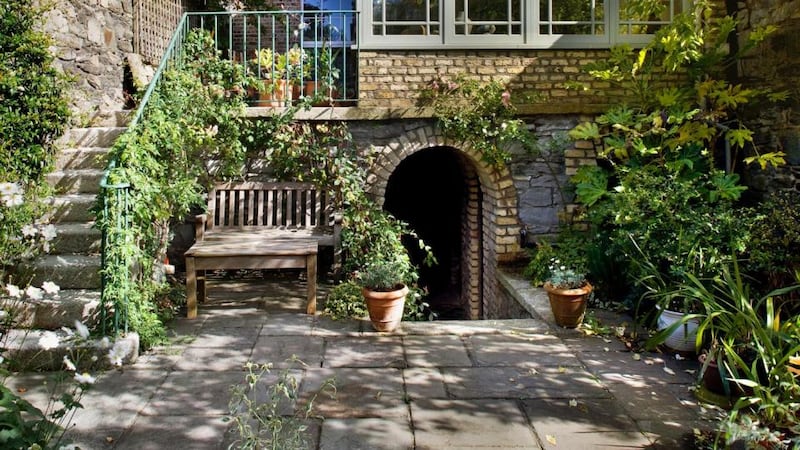
2. Original features
The courtyard of this fine period property has made the most of its original features, like the granite stone steps leading down from the newly installed timber orangery, a design by Hamptons that features marginal bars and a sage green colour. It is part of a refurbishment by architect Adrian Hill that contrasts really well with the original brickwork and salvaged limestone slabs found by its owner at Deckclad, also known as Architectural Salvage, on Dublin’s Naas Road. To do the job right, the paving has to be set on to paving grit as opposed to sand and pointed with a product that water can penetrate. Installation is €75 per square metre and includes digging the ground and installing it, says Joe O’Reilly of Donnybrook-based Arc Construction who laid this patio over a decade ago. Swan Lake climbing roses fill the wall while more roses arch over the vaulted wine cellar, accessed via the brick arch. The plants in the terracotta pots are daisies.
Adrianhill.ie; Arcconstruction.ie; Architecturalsalvage.ie
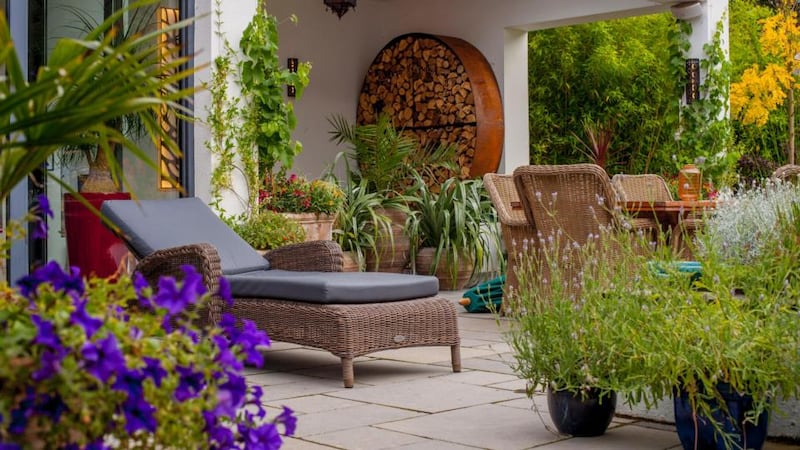
3. A Moroccan theme
This garden area required a total revamp recalls garden designer Damian Keane. He chose a Moroccan theme and used palms, antique-style urns, authentic Moroccan lighting and coffee table and an outdoor fire to turn a covered area used to store garden furniture into a garden room. The fire is fed timber, creatively stacked within a corten steel ring to create a piece of wall art. Any paving or patio slabs laid with sand and or cement needs to relaid every eight to 10 years because over time you get subsidence and the pointing cracks, he explains. The black limestone paving (pictured, €25 per square metre) was sourced from Delgany-based Millbrook Paving and he used resins and patio sealants to prolong the life of the patio by at least another 10 years. The pots in the covered area are Greek-styled urn in a clay antique finish that can be sourced from good garden centres. The palm in the centre urn is a Phoenix canariensis and the silver leafed plants are Astelia. The Bridgman lounger can be left out all year round. On the back wall is a large back-lit laser-cut art piece from UK-based Miles & Lincoln.
Damienkeane.com; Millbrookpaving.ie; Milesandlincoln.com
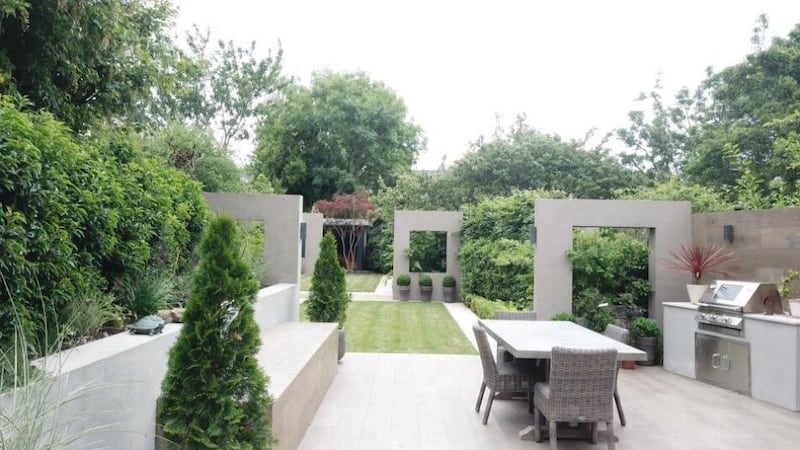
4. Porcelain tiles
These low maintenance, wood-like, porcelain tiles have been used to replace traditional timber decking and look really smart in this Dublin 6 home. Only one cm thick, they’re light to use but costly to install, cautions designer Ross Farrell of Greenstone Landscapes. There’s a lot of unseen work, he explains: excavation, compacted sub-base, installing reinforced mesh, setting in the drainage and then pouring the concrete slab before you bond them to it so expect to pay between €220 to €240 per sq metre including concrete and tiles. The non-slip Porcelanosa tiles (pictured) come in about five different wood-stain colours and a couple of different finishes. Pictured is a grey colour that can be sourced from Cork city-based OB Cork where prices start from about €89 a square metre, ex-works. Rathnew-based Miller Brothers and Tilestyle also stock the range.
Greenstonelandscapes.com; Obcork.ie Porcelanosa.com
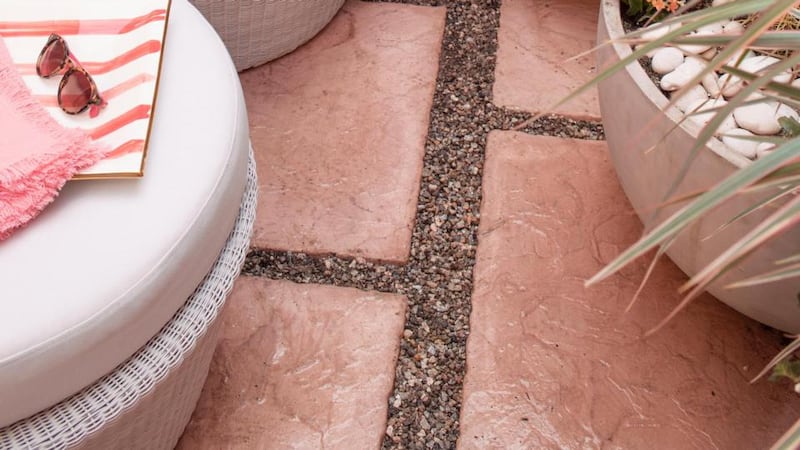
5. Contrast
A very easy way to create a paving effect and one you can do yourself is to lay slabs on to a gravel base, the fashion now being for the base to tone with tile uppers. As a style, this can work really well in a small patio, terrace or balcony. A extra-thick natural terracotta slab, 23mm in depth, will withstand frost and the 30cm squares are available to order from Italian Stone & Tile where they cost about €85 per square metre. To achieve the finish, the slabs are first sealed and then polished, owner Luke Sweeney explains. The indoor and outdoor use Flamingo cushions cost about €107 each, ex-delivery, from Dash & Albert.
Tiles.ie; Dashandalberteurope.com

6. Riverstone
River stone is a classic garden treatment that has been used in Italianate and Victorian designs in paving. It also works well in mosaics, says gardener Dermot O’Neill, who is this year’s GroMor ambassador, an initiative that offers free expert advice to get ordinary people growing, in 75 of the nation’s garden centres and nurseries. This style will turn shaded areas into a point of interest and add texture to paths and can be sourced from good architectural salvage yards. BG Salvage on Dublin’s South Circular Road is currently selling a tonne bag for about €200, which will do five or six metres, explains owner Joe Byrne. The stool is a design by Italian furniture firm Colos.
Dermotoneill.net; Gromor.ie; Colos.it
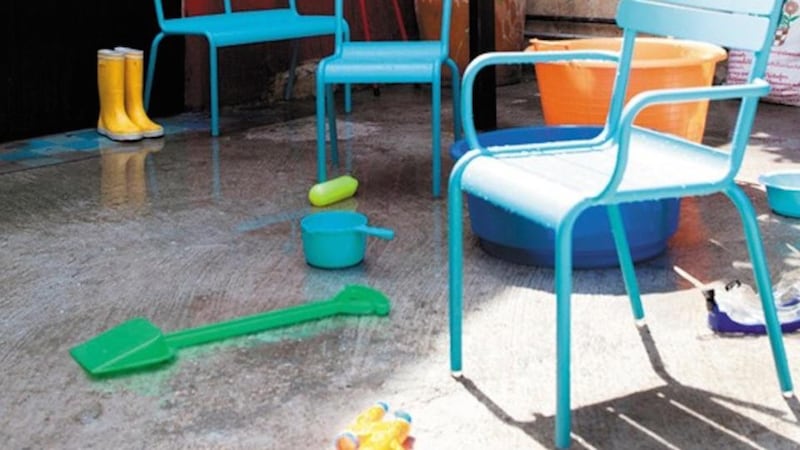
7. Polished concrete
If you like a very contemporary style then opt for a seamless look by using polished concrete both inside and outdoors. Basic costs, including to supply, lay and pour concrete, are about €40 per square metre, something any good contractor can do. The art is in the finish, says Marc Barrett of Cork-based Solido who says you can expect to pay from €60 per square metre to grind, polish and seal the concrete to achieve a finish like that pictured. He says it takes a little bit of maintenance and you need to seal it every couple of years to keep it looking fresh. And if you’ve ever walked the east pier in Dún Laoghaire and hankered after its river stone and sea shell chip finish you can expect to pay roughly the same price, Barrett explains. The Luxembourg aluminium outdoor seating by Fermob and available in eight different colours, costs €387 for a set of two dining chairs, €397 each for the armchairs and €145 for the kids’ bench to the rear of the shot. They can be ordered from online store Smallable.
Solido.ie; Smallable.com
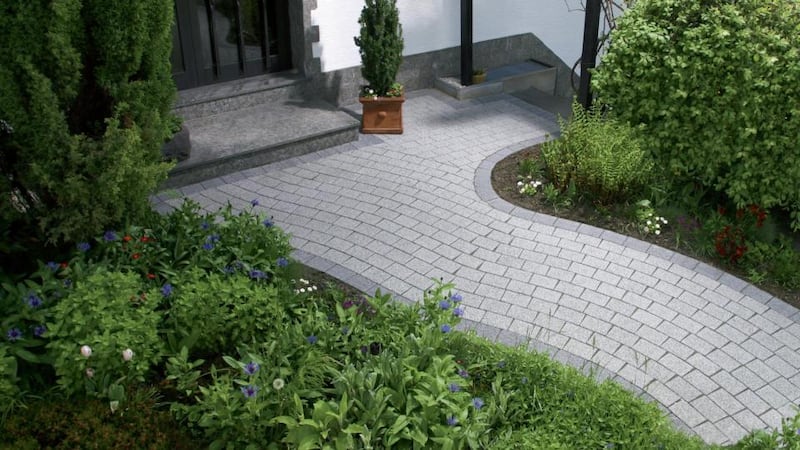
8. Classic patterns
There are several classic patterns to use when laying paving: herringbone, basketweave, circular, offset and stretcher bond. They feature Roadstone’s Verona white granite-look concrete and work really well in a small space. The blocks come in three colours, two of which are pictured, and in two sizes – in 60mm or 80mm thick options. The 60mm is used for paths while the thicker option, the 80mm, is used for driveways. Prices start from €24 including VAT, per square metre and these concrete grey colours work really well when mixed with pink sandstone paving to create a pattern or to border the grey with a softer shade.
Roadstone.ie












